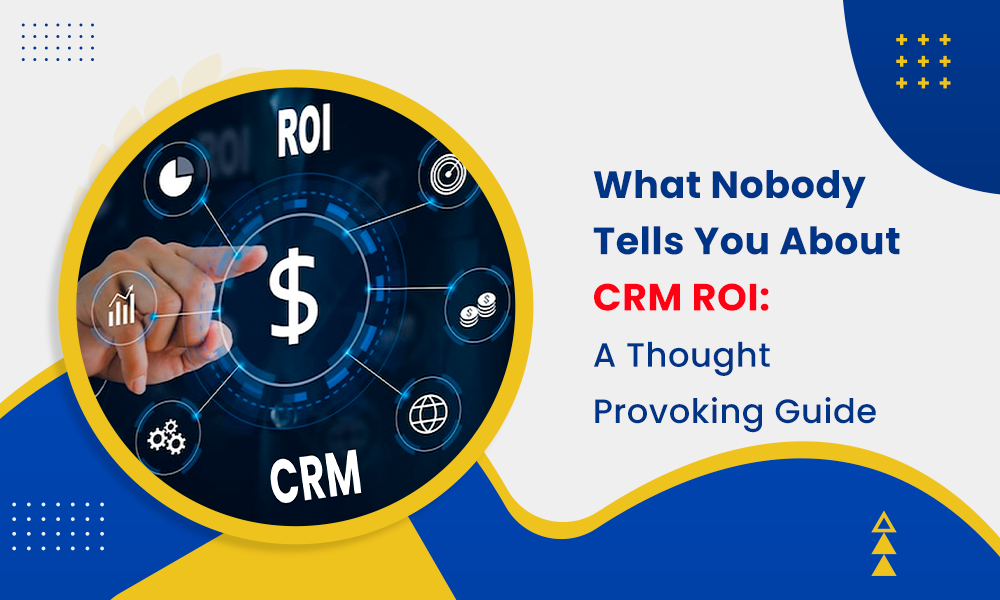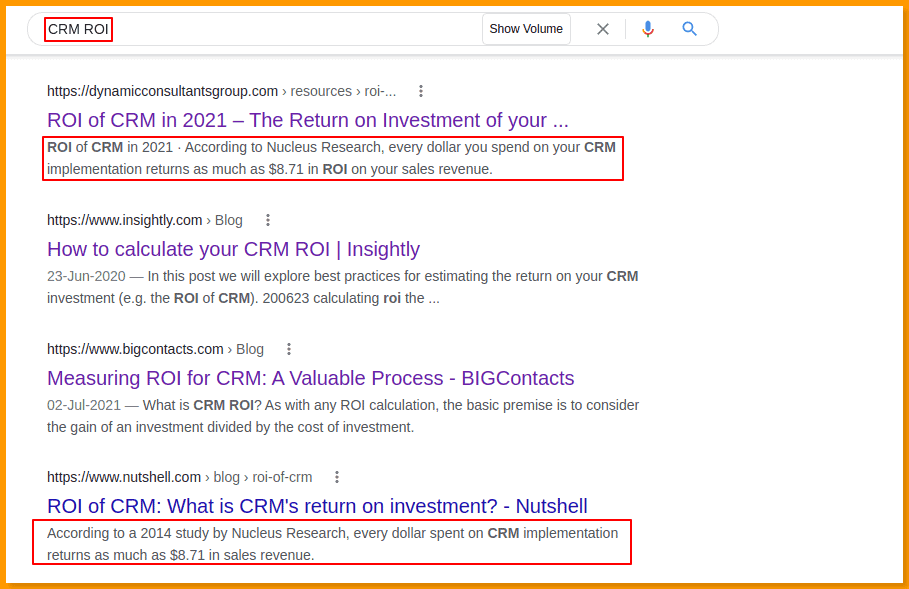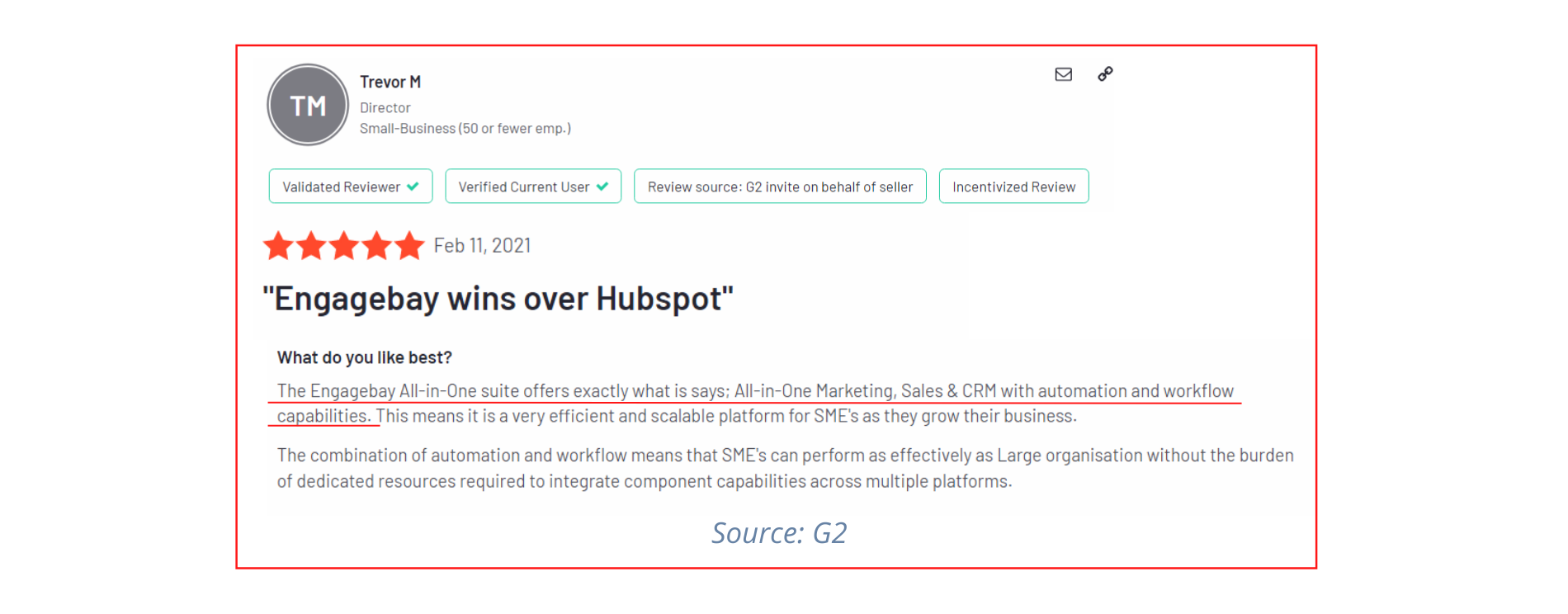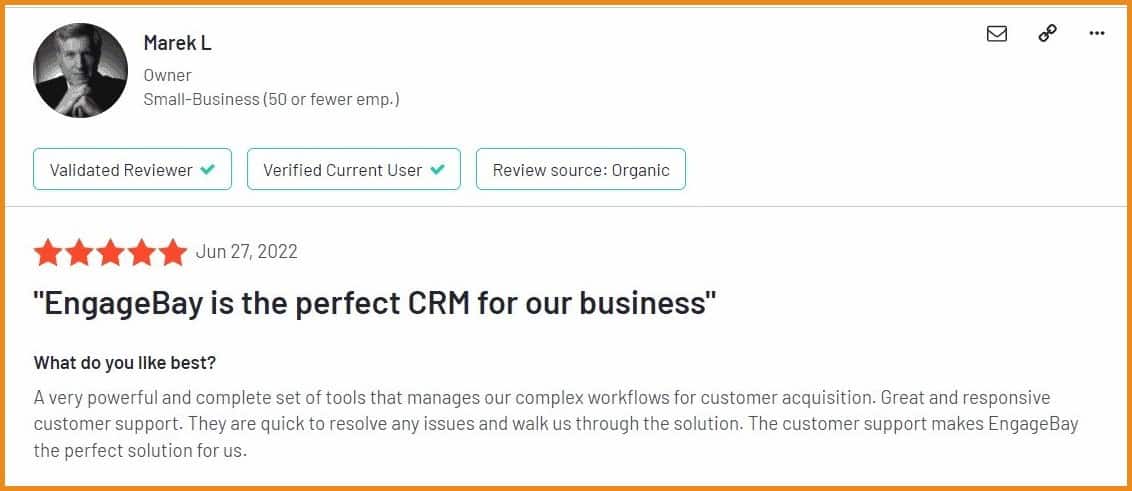Have you ever wondered if the tools you implement in your business generate positive revenue? What about your customer relationship management (CRM) solution?
Do you know your CRM ROI?
If you’re considering a CRM for your business, you must know the ROI, or return on investment, for a CRM.
That’s why we’ve meticulously researched and written this blog for you.
In this ultimate guide, we’ll cover: ✔ The definition of CRM ROI ✔ The average ROI of CRM according to studies ✔ How to practically calculate the ROI of your CRM ✔ The factors that can improve the ROI of CRM solutions ✔ A few examples of case studies and research conducted on CRM ROI ✔ The veracity of the widely quoted Nucleus Research claims ✔ Why CRM implementations fail ✔ The best solution for small businesses to increase CRM ROI
Let’s get started!
Table of Contents
What is CRM ROI?
CRM ROI is a measure of the business value of a customer relationship management (CRM) solution. It measures the return on investment (ROI) for your CRM solution by determining how much money it brings in compared to how much it costs.
While ROI is sometimes expressed in dollars, it is inherently a ratio. In essence, CRM ROI is the ratio of income earned to the cost of CRM implementation.
The ultimate goal is to have a CRM ROI of more than ‘1’ or 100%. This ensures that businesses don’t lose money and that the benefits of CRM outweigh the cost of implementing CRM.
The basic formula for calculating the ROI of CRM is quite simple:
CRM ROI = (Gains from CRM investment – Cost of CRM investment) / Cost of CRM investment
To simplify and express the ROI in %:
CRM ROI = (Total profit / Total investment) * 100
That said, this formula does not offer the full picture.
Why?
That’s because forecasting or estimating the ROI of a CRM system is not as straightforward as calculating, let’s say, the returns of a promotional campaign.
TL;DR — If you’re not a big reader, you can watch this video instead:
Let’s get our hands dirty and find out what really impacts the ROI of CRM, and ways to improve profitability.
How Much ROI Should You Expect From Your CRM?
In 2011, a study by Nucleus Research found that the average ROI of CRM was $5.60 for every dollar invested.
According to Rebecca Wettemann, the VP of research (Nucleus Research):
“With a return of $5.60 for every dollar spent, investing in CRM is a no-brainer. Further, that investment has significant staying power. As vendors add social, marketing, analytics, and mobile access capabilities to their offerings, organizations have an opportunity to gain even more returns from CRM”
Then in 2014, another study by Nucleus Research found that the ROI rose to an as astounding $8.71 for every dollar invested – a claim that cemented the importance of CRM systems for businesses.
And if this is not enough, an estimate by Dynamic Consultants Group shows that the ROI of CRM could have shot up to a whopping $30.48 for every dollar spent (in 2021).
But all these mind-blowing numbers don’t mean anything without the correct approach, right?
Read also: CRM Implementation Guide with Exact Steps
How Do You Practically Calculate the ROI of CRM?
We know the formula we’ve shown above is so simple that it’s “too good to be true.”
Though the formula is correct, calculating the ROI for CRM is more complicated than say, calculating the returns of a marketing campaign.
Let me put it this way: how do you calculate the gains from investing in a CRM? It is, after all, just a tool.
You can’t just calculate your revenue and measure it with the cost of CRM – there are so many overhead costs that must be included.
Lawrence and Buttle, in their study “ROI on CRM: a customer-journey approach,” illustrates the pain points of deriving the CRM ROI. Here’s an excerpt from their study:
“In the conventional ROI formula, return is defined as profit. However, tracing profit consequences of CRM investments is extremely difficult if not impossible at the strategic level of analysis. Other factors such as superior customer-valued quality, efficiency of distribution, brand image or corporate reputation may all be important determinants of sales and profitability.”
Fortunately, there are ways to quantify various metrics so that you can finally make the CRM ROI calculation.
Spoiler alert: it’s not that easy.
Let’s first list the steps to measure gains, and then move on to calculating the costs.
Read also: What are CRM Systems? A Definitive Guide (Benefits, Challenges)
How to measure the gains from your CRM implementation
To actually measure gains, you need to know how your business was performing before you implemented the CRM. Called the ‘baseline,’ this helps you figure out how the CRM tools are used by your teams to improve business processes – another important benefit of calculating your ROI.
Enough beating around the bush. Let’s dive in and see each metric and how it helps you calculate the overall ROI.
Cost per lead (CPL)
The Cost Per Lead, or CPL, is a metric that measures the effectiveness of your marketing campaigns and teams in terms of generating leads for your sales team.
It includes all the costs associated with generating leads, including salaries, pay-per-click campaigns, and any other costs.
Simplified formula for cost per lead:
Cost per lead = Cost of generating leads / total leads acquired
A CRM software can automate, capture, and streamline lead generation processes – making it easier for marketing teams to generate leads. Simply put, a CRM software can get more leads with less sales and marketing efforts, thereby reducing expenses.
Revenue per lead (RPL)
Revenue per lead is commonly used by marketing and sales teams to calculate the revenue generated from each lead.
Simply put, the formula is calculated by taking the total revenue generated by leads and dividing it by the number of SQLs, or sales-qualified leads. It is usually calculated quarterly or annually.
Here’s how: If your annual revenue is $500,000 and you got 500 SQLs, then,
Revenue per lead = $500,000 / 500 = $1,000 per lead
Calculating revenue per lead is beneficial because it shows how effective your marketing and sales teams are. But more importantly, it helps you understand the lifetime value of your customers.
A CRM software helps acquire and provide information about lead behavior, customer satisfaction metrics, and conversion rate, and improves efficiency. It can also provide valuable sales data on upselling and cross-selling.
Overall revenue
It goes without saying: Overall revenue is the most important metric to measure.
Fortunately, it’s the easiest.
Simply compare overall revenue post-CRM with pre-CRM, and you’ll know if your CRM implementation has come to fruition.
For example, say Business X has a subscription-based model. For the sake of simplicity, let’s say there are no upselling and cross-selling opportunities.
Total annual revenue = subscriptions sold × annual cost of each subscription
Before CRM implementation, the business sold 4,000 copies. So,
Total annual revenue = 4,000 × $500 = $2,000,000
After CRM implementation, the business sold 6,700 copies. So,
Total annual revenue = 6,700 × $500 = $3,350,000
It’s clear that the revenue grew by around $1.3 million in one year.
A word of caution. If your CRM is too complicated to use, the initial training cost and learning curve may affect the ROI of CRM. Fortunately, most CRM vendors offer in-depth training and onboarding to make the transition easier.
Read also: CRM Functionality: 12 CRM Features That Fuel Growth Hacking
How to measure the cost of implementing a CRM solution
Measuring costs can be easier than measuring gains (in most cases).
You simply have to calculate the actual cost of the CRM software – upfront costs, monthly subscriptions, training costs, and more. Also, factor in the loss during the CRM deployment phase.
Example Cost of CRM Implementation (includes onboarding)
Here’s a simple example of calculating the cost of implementation for Business X:
|
CRM implementation stage
|
Cost
|
|
Research and planning cost
|
$2,000
|
|
Implementation
|
$3,200
|
|
User training and onboarding
|
$1,500
|
|
Post-live support
|
$1,000
|
|
Total cost of CRM implementation
|
$7,700
|
This is just an example quote to give you an idea of what the costs may look like. Please understand that the cost of CRM implementation may vary for different companies.
Read also: These CRM Modules Can Skyrocket Your Customer Loyalty
Example CRM usage cost for one year
You’ve got the implementation costs right; the next step is to calculate the total CRM cost for one year. Here’s an example:
|
Particular
|
Cost
|
|
CRM implementation costs (previously calculated)
|
$7,700
|
|
Annual subscription costs
|
$3,600
|
|
Premium support costs (if any)
|
$600
|
|
Total annual costs
|
$11,900
|
In the end, it’s all about the cost – your CRM software should lift the bottom line. Otherwise, it is pretty useless.
A CRM software should be able to help your teams offer better service to your customers. This should, in turn, increase your sales revenue and reduce acquisition costs.
While we’ve mentioned the most important factors, here are some more metrics you can use to measure the ROI of your CRM: break-even points, sales cycle efficiency, sales process improvement, and more.
Read also: CRM Database: Enhancing Your Customer Relationships
How Can Businesses Maximize CRM ROI?
There’s a lot of play when it comes to CRM. But these are the key factors that can help maximize the ROI of your CRM:
Choose a cloud-based CRM
Choosing a SaaS-based CRM software has numerous benefits. Getting a cloud-based CRM software means you don’t have to worry about maintaining any form of hardware or infrastructure, servers, IT experts, and maintenance.
In addition, most subscription-based CRM software are quite affordable and more secure than on-premise CRM software, especially for small businesses. Cloud-based CRM adoption also works well for SMBs with a small existing customer base, as this can result in higher marketing ROI and greater customer retention (by negating the need for installation, resources, and maintenance).
Choose a CRM tool with integrations
Integrations expand the capabilities of CRM software.
Choose a software that offers the integrations you need – you may need telephony, automation, social media, calendar, accounting, and other platforms.
Find out the exact features you need
Choosing a CRM software that has the features you need is of paramount importance. In fact, you need to choose the plan that aligns with your team’s needs. Spending money on features you don’t require is a complete waste.
Read also: Return on Sales: Does Your ROS Make Sense Yet?
Modify your business processes around the CRM solution
Here’s a tip you won’t find in many blogs: you must modify your business processes and other tasks around the CRM – not the other way around. In essence, this means you need to ensure that each business process is streamlined to improve efficiency. The result? Better CRM capability and customer success.
Define your CRM strategy
This is perhaps the most important tip. Ever.
CRM does not magically solve everything. It’s just a tool and, when used correctly, can yield astounding results.
But before anything of the sort can happen, you need a sound CRM strategy in place. You need to know why you’re implementing the CRM, and define crystal-clear objectives.
Find out how to create a decisive CRM strategy for your business.

Read also: How Much Does CRM Cost?
CRM ROI Case Studies
Intensive research and studies have been conducted regarding the ROI of CRM. I’ll list a few awesome case studies (some might be boring:-( ):
- CRM pays back $8.71 for every dollar spent – Nucleus Research
- ROI on CRM: a customer-journey approach — Lawrence and Francis
-
Calculating Your CRM Return on Investment — Jenny Jones
Read also: What are CRM Systems? (Benefits and Challenges)
For the Curious-Minded: Scrutinizing the Viral Nucleus Research
If you are in the B2B industry, you’d definitely have come across the estimates quoted by Nucleus Research (hell, even we mentioned it throughout this blog!): For every dollar spent, CRM offers a return on investment of $8.71 …
Just typing “CRM ROI” in Google search yields dozens of pages that have articles all quoting the same research.
But how true is this study?
Fair warning, I’m not here to diss Nucleus Research or their studies. But it’s impossible to turn a blind eye to the often quoted estimate. In fact, no other software category promises an ROI of 870%.
There’s an interesting article I came across that challenges this study. According to this article:

My only take from the research and this article is that not all businesses should believe that just implementing a CRM solution can yield the returns promised by the said case study.
While the research could be theoretically correct, a lot of factors are at play. This is especially true for small businesses where saving cost is extremely important.
That’s why small businesses should choose a CRM technology that is affordable, easy to use, and has the tools they need. For example, choosing HubSpot as their CRM solution could spell disaster for small businesses in the long run.
While HubSpot is an amazing CRM and one of the best in the industry, the price tag is simply too much to give small businesses a positive ROI.
Here’s how much HubSpot’s Starter plan costs as the number of contacts increases:

Read also: Is HubSpot CRM Free? An Unbiased Guide (with User Reviews)
On the Flip Side: How to Avoid CRM Failures
We’ve been going on and on about the positive effects of implementing a CRM solution.
But ever so often, things don’t go as planned – and that’s the sad truth.

According to CIO, the failure rate of CRM projects is around 33%.
To put that into perspective, around 1 in 3 CRM implementation projects fail to yield a positive ROI. It’s hard to digest this, but it’s important to take a look at the reasons that cause failures in CRM implementation.
Reasons for CRM Failure
- Unreasonable expectations: Many zealous owners and decision-makers set unrealistic CRM goals, expectations, and schedules while implementing a CRM solution. CRM is just a tool, after all, and not a magic wand that solves all problems.
- CRM Data integrity: Even if the CRM platform is working fine, duplicate, improperly assigned, and inaccurate customer data play a major role in creating data quality problems. This, in turn, can adversely affect user satisfaction.
- Budget constraints: Oftentimes, businesses choose an expensive CRM vendor that may not play well with their marketing and operational budget. An expensive CRM solution usually has complicated tools and may need expensive, complex onboarding before teams can use it practically. Expensive CRM adoption can negatively impact the ROI of CRM.
Finally, with multiple decision-makers comes varying objectives.
There’s sales, marketing, finance, IT, and most importantly, the C-suite. With every team and member weighing in their requirements, the main objective gets convoluted to the point where there’s no clear direction.
This excerpt from a Harvard Business Review article perfectly summarizes the mess:
“The EVP of marketing was pleased she could now track the assignment of every single lead. The CIO was unhappy about data integrity issues that arose from the integration of more than 20 discreet databases. The EVP of sales liked the easy-access dashboard to report on metrics and the forecast. Sales management was less positive but acknowledged that it helped them monitor activity. And the sales team — well, they mostly hated it.”
So, what’s the solution?
- Think of your CRM as a tool to generate better revenue: Everyone from top executives and sales management to sales reps should know that it is a tool to help close more deals, and not a mundane office requirement. That’s why choosing the right CRM is important.
- Integrate marketing with sales: This cannot be stressed enough. That’s why choosing a CRM solution that unifies marketing and sales is essential (and many CRM solutions do not have this important feature).
Read also: 9 Challenges of CRM Implementation & How to Dust Them Off
A Solution For Small Businesses to Improve CRM ROI
We’ve said it before, and we’ll say it again. Small businesses need a unified, easy-to-use, and affordable CRM solution in order to achieve a positive CRM ROI.
While there are dozens of CRM vendors in the market today, not all of them are suitable for small businesses.
That’s where EngageBay comes in.
EngageBay is an affordable, unified CRM solution designed specifically for small businesses. The keywords here? Affordable. Unified.
Here are a couple of reasons to choose EngageBay:
- Reason #1: EngageBay’s CRM starts at just $11.99/month, while the Pro plan offers unlimited contacts and enterprise-level tools for just $79.99/month. Plus, EngageBay offers free onboarding and migration services.
- Reason #2: As we said before, one of the main reasons CRM implementation fails is because marketing and sales are not unified. EngageBay unifies marketing, sales, and customer service which offers a 360-degree view of your customers while also improving customer experience and CRM performance.
Want to know why EngageBay could be a great choice for your business? Check out this comparison:
|
Factors that improve CRM ROI |
EngageBay |
| Choose an affordable CRM | ✔ Is one of the most affordable CRM solutions |
| Choose a CRM with a good onboarding solution to minimize the transition period | ✔ Offers free onboarding and migration services |
| Choose a cloud-based CRM | ✔ Is a cloud-based SaaS CRM software |
| Integrate marketing with sales | ✔ Offers a unified marketing, sales, and customer support software |
| Choose a CRM with integrations | ✔ Offers dozens of native integrations and thousands of third-party integrations |
Thousands of SMBs and startups use EngageBay to solve their business problems and increase revenue.
Read also: 8 Reasons Why Every Small Business Needs an Easy-to-Use CRM Software
Conclusion
We’ve seen how powerful implementing a CRM solution can be. We’ve seen the numbers, we’ve questioned the authenticity, and we’ve seen the flip side.
CRM software is an important tool that can generate revenue for your business.
But it’s not magic. At the end of the day, it’s your marketing team that’s responsible for bringing in leads; it’s your sales team that needs to offer value to customers and close deals.
This is how you amplify the ROI of your CRM solution.







